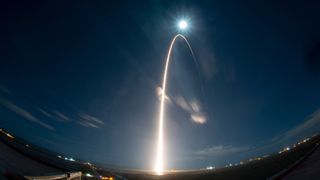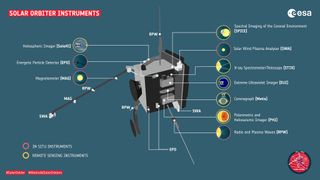What's next for Solar Orbiter after its historic launch to the sun
Solar Orbiter has a long journey ahead.

CAPE CANAVERAL, Fla. — Solar Orbiter, an international collaboration between NASA and the European Space Agency (ESA), successfully launched on Sunday, Feb. 9. It's goal: to study the sun up close.
After lifting off at 11:03 p.m. EST (0403 GMT on Feb. 10) from Space Launch Complex 41 at Cape Canaveral Air Force Station here in Florida, the craft is now on its way towards the inner solar system. About an hour after liftoff, the spacecraft separated from the rocket's upper stage as planned, extended its solar arrays and sent a signal back to Earth that it had power.
It will take Solar Orbiter about two years to reach its operational orbit around the sun, where it will capture unprecedented views of our star's poles. But the spacecraft still has plenty of work to do before it can start working on its science goals. Here's an overview of what's next for Solar Orbiter.
Related: The Solar Orbiter mission to explore the sun's poles in photos
Over the next few days, the craft will be busy deploying its communication antennas as well as its instrument boom. Solar Orbiter is on a unique trajectory that will allow its suite of instruments to capture the first images of the sun's poles.
Solar Orbiter will spend its first three months in a commissioning phase, during which ground controllers will check out its science instruments to make sure everything is in working order. Two years from now, it will be close enough to the sun to begin taking detailed measurements of the sun. But that doesn't mean we have to wait that long for the first bits of science data. Fabio Favatta, ESA's head of science program communication told Space.com that the instruments on the boom will be the first to be switched on.
"As soon as the boom is extended, the first instruments like the magnetometer are switched on," he said. These instruments also include solar wind analyzers and energetic particle detectors. The instrument boom is expected to deploy 36 hours after liftoff, or this Tuesday (Feb. 11) around 11 a.m. EST (1600 GMT).
Get the Space.com Newsletter
Breaking space news, the latest updates on rocket launches, skywatching events and more!

Solar Orbiter's suite of instruments combines two different modes of study: In-situ, which will measure the environment around the spacecraft; and remote-sensing, which will image the sun from a distance.
Solar Orbiter will make 22 close approaches to the sun over the next 10 years, and complete multiple gravity-assist flybys of Venus in order to put it in the perfect position to look down at the sun's poles. "The first big science objectives will be achieved after the first Venus flybys," Favatta added. "That's when we get close to the sun. We know that the cruise phase will be long, it's part of the design of the mission."
During the mission's cruise phase, which lasts until November 2021, the spacecraft will conduct three planetary flybys to help slingshot itself closer to the sun: two past Venus (in December 2020 and August 2021), and one past Earth in November 2021.

Once Solar Orbiter completes its planned Earth flyby, it will be in a position to begin the primary phase of its mission. Over the course of five years, the spacecraft will gradually fly closer to the sun, placing itself in an elongated, looping orbit. Its first close pass of the sun is scheduled for June, and the craft will complete a few more Venus flybys throughout its mission to gradually increase the tilt of its orbit, until it is able to look down on the poles.
Although the first major bits of science data aren't expected to be returned for quite some time, Nicky Fox, director of heliophysics for NASA, told Space.com that we could start to receive science data as early as May.
Solar Orbiter is equipped with instruments that are similar to those found on another sun-observing spacecraft — NASA's Parker Solar Probe. According to Fox, the two will be able to work together to provide a complete picture of the sun's processes.
"We waited 60 years to get a spacecraft in the inner heliosphere, and now within 18 months we have two of them up there," Fox said. "It's a great time for heliophysics."
Related: Our sun will never look the same again thanks to missions
Solar Orbiter will join Parker Solar Probe just in time for the record-setting probe's fifth perihelion (or close pass by the sun) in May. Solar Orbiter, orbiting from a distance of 26 million miles (42 million kilometers), will observe the NASA spacecraft while it studies the sun's activity, allowing the science team to compare the data collected by both spacecraft to better understand solar activity. This type of collaboration will continue throughout the next decade as NASA and ESA work in tandem to unlock the mysteries of our star.
Solar Orbiter is the first spacecraft tasked with linking the sun to the heliosphere — the sun's giant magnetic "bubble" that extends far beyond Pluto — and attempting to establish a cause-and-effect relationship to what happens on the sun with what we observe in the near-Earth environment.
This vital information will help scientists fill in the gaps in models of the sun's magnetic field, which drives the 11-year solar cycle. As the activity increases over the course of its 11-year cycle, so does the number of sunspots, radiation levels and amount of material ejected from the sun (known as the solar wind).
This material can affect us here on Earth, creating beautiful auroras in the sky and even interfering with communications systems and power grids. By studying the sun up close, Solar Orbiter will help scientists better understand these processes.
The first polar pass is expected to take place in 2025, with the spacecraft reaching an inclination of 17 degrees above the ecliptic plane — the plane where the Earth and other planets orbit the sun. This is when the first views of the sun's poles will come in.
"It takes a lot of energy to pull a spacecraft out of the ecliptic plane," Fox told Space.com. "So we need several Venus flybys." To that end, the spacecraft will use Venus to gradually increase the tilt of its orbit from 17 to 24 to eventually 33 degrees. That will give the spacecraft a great vantage point to look down on the sun's poles.
Although the best views won't arrive until the end of the mission in 2029, scientists are expecting a treasure trove of data from these first images arriving in 2025. To date, no other mission has ever taken images of this dynamic region.
Another NASA spacecraft, Ulysses, did fly over the poles, but did not have an imager. It was able to take some measurements, which showed that the sun's magnetic field at the poles is very different than the magnetic field at the rest of the star. This solidified the case for Solar Orbiter's mission.
Günther Hasinger, ESA's director of science, told Space.com that the team hasn't decided yet how the mission will end. According to Hasinger, there are three potential fates for Solar Orbiter: the spacecraft could stay in its final orbit, collecting data until its on board fuel runs out, the craft could continue to use Venus to slingshot itself out into oblivion, or the craft could crash into Venus.
Hasinger says that Solar Orbiter's instruments are not designed to withstand a trip through the Venusian atmosphere, but that it would be interesting to see what sort of data they could collect before the spacecraft was destroyed.
Solar Orbiter's fate will be decided well into its mission. But first, the craft will journey to the sun and beam back some incredible images of our star.
- The greatest missions to the sun
- Sun science rises with new trove of Parker Solar Probe studies
- World's largest solar telescope produces never-before-seen image of our star
Follow Amy Thompson on Twitter @astrogingersnap. Follow us on Twitter @Spacedotcom or Facebook.

Join our Space Forums to keep talking space on the latest missions, night sky and more! And if you have a news tip, correction or comment, let us know at: community@space.com.

Amy Thompson is a Florida-based space and science journalist, who joined Space.com as a contributing writer in 2015. She's passionate about all things space and is a huge science and science-fiction geek. Star Wars is her favorite fandom, with that sassy little droid, R2D2 being her favorite. She studied science at the University of Florida, earning a degree in microbiology. Her work has also been published in Newsweek, VICE, Smithsonian, and many more. Now she chases rockets, writing about launches, commercial space, space station science, and everything in between.
